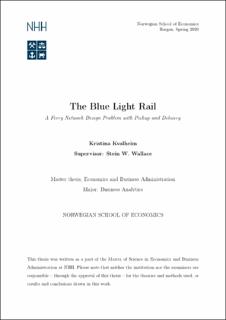The blue light rail : a ferry network design problem with pickup and delivery
Master thesis
Permanent lenke
https://hdl.handle.net/11250/2681174Utgivelsesdato
2020Metadata
Vis full innførselSamlinger
- Master Thesis [4372]
Sammendrag
Urbanization, global sustainability issues and a growing population raises concerns for
transportation and city-logistics. Increasing supply of transportation alone is not sufficient
to meet a growth in transportation. In addition, concerns for increasing pollution and
congestion set barriers to traffic. Authorities aim for zero-emission logistics in city centers
to meet the Paris agreement and thus address climate change to keep global temperatures
from rising above 2°C. Although zero-emission vehicles can reduce the sustainability
problem, it interferes the overall congestion. The municipally of Bergen has introduced
a solution to these issues. Whilst increasing the public transportation offer by utilizing
the inner sea, they aim to create a ferry-service for short-distance travelers. Moreover,
waterborne public transportation has shown to be an effective way to provide large-scale
transportation for an urban area, and has already been implemented in cities worldwide,
such as Amsterdam, Copenhagen and Brisbane.
The idea of a "Blue Light Rail" was first introduced in 2017, but due to high uncertainty,
the idea has yet not become practice. Throughout this thesis, a representation of a ferry
network design with pickup and delivery (FNDPPD) will be introduced to shed light over
some of the questions yet to uncover. The approach is used to investigate how a Blue
Light Rail can supplement the transportation offer in the city of Bergen by most efficiently
fulfil demand. Experimentation under high uncertainty is conducted, and the analysis
uncover the potentials and shortcomings for the service. Pre-set routes are generated and
demand is distributed using real bus-data. By utilizing a column generation approach,
the model aims to search for the combination of routes that minimizes the required ferries,
concerning an estimated demand. Whilst the model aims to minimize a set of routes,
further analysis can supplement the research by considering factors such as costs, travel
time or the conflict of interest between the operators and passengers.
Keywords – FNDP, PDP, Passenger transportation, Electric vessels, City logistics
